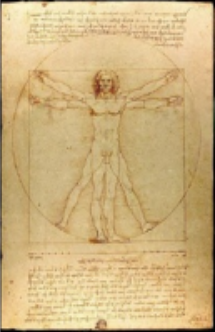 The Vitruvian Man is Leonardo da Vinci’s own reflection on human proportion and architecture. Many sources communicate clearly that is through precise words and images that the purpose of the illustration of the Vitruvian Man is to bring together ideas about art, architecture, human anatomy and symmetry in one distinct and commanding image. Yet, by mixing text and illustration, da Vinci evokes a meaning which could not be created through words or image alone.
The Vitruvian Man is Leonardo da Vinci’s own reflection on human proportion and architecture. Many sources communicate clearly that is through precise words and images that the purpose of the illustration of the Vitruvian Man is to bring together ideas about art, architecture, human anatomy and symmetry in one distinct and commanding image. Yet, by mixing text and illustration, da Vinci evokes a meaning which could not be created through words or image alone.
I would like to discuss the connection of the Vitruvian Man and Plastic Surgery this month. In January we discussed men and their beards and the proportion and importance of the balance of the chin in relation to other features on a man’s face and in February and March we spoke about the eyelids and eyes and the importance of balance in the beauty of women. Yet, now, I would like to discuss the overall importance of proportion in both men and women.
In the book Da Vinci’s Ghost, Leonardo da Vinci’s passion and work, is explored. In particular, the ideas behind his Vitruvian man – his famous drawing of a man in a circle and a square. I thoroughly enjoyed the book, but as a plastic surgeon, it reminded me of the irony associated with this iconic image so this brings me to Leonardo Da Vinci’s motivation. What was his inspiration?
Leonardo’s Inspiration
Leonardo’s inspiration for this drawing was from the concepts of Vitruvius, a Roman architect in the first century BC. Vitruvius was in turn inspired by the ancient Greeks. The ancient Greeks observed that musical notes created by strings whose lengths were in simple numeric ratios were intrinsically pleasing. They extended this concept to spatial intervals and established the concept that harmonic ratios were intrinsically “right” and thus fundamental to the structure of the universe. In the first century BC, Vitruvius adapted the proportional concept to the human body. He
proposed that the body should be divisible into equal parts, and that all of its units should be expressible in terms of that unit or fractions of the whole. Vitruvius also described the ideal human form as something that “could be made to fit inside a circle (long associated with the divine) and could be made to fit inside a square (related to the earthly and the secular)”. According to Vitruvius, the ideal human body could therefore be used as a blueprint for all design.
Vitruvius’ treatise De architectura, which described his proportional system, was one of the few Classical texts which survived to the Renaissance and became highly influential in the thinking of artists and scholars of that time, including Leonardo Da Vinci. Early in his career, Leonardo adopted many of Vitruvius’ ratios. Most of us today associate Leonardo’s anatomy drawings with his rendition of Vitruvius’ ideal proportions for the human body whereby “the body when standing with arms stretched fits into a square and, with all limbs splayed, into a circle centered on the navel.” Leonardo soon found limitations in the use of proportions to depict the human form. He realized that the umbilicus was not in the middle of the body and drew his Vitruvian man with the square slightly below and outside the circle. And then by 1500, the idea of a single canon of ideal proportion to describe the human body was abandoned. Furthermore, in the winter of 1510, he collaborated with the professor of anatomy at the University of Pavia, named Marcantonio della Torre. This relationship provided Leonardo access to human material, allowing him to depict human structure with great accuracy. As Leonardo learned more about human anatomy, he realized that the use of ideal proportions thwarted its accurate depiction. He used proportion as a tool to help describe its form and function rather than as an end to itself.
Plastic Surgery
Neoclassical canons are routinely referenced in plastic surgery texts addressing the planning of aesthetic facial procedures. However, neoclassical canons have a limited role in surgical evaluation and planning, because similar to what Leonardo found, they are based on idealizations. When the dimensions of normal males and females were evaluated objectively and compared to these artistic ideals it was found that some theoretic proportions are one of many variations found in healthy normal individuals, or those determined more attractive than normal individuals, and some are never found. The neoclassical canons do not allow for facial dimensions known to differ with sex and age. Most of these canons of proportion, for example the width of the upper face is equal to five eye widths, are interesting but hold for few individuals. They cannot be obtained surgically and/ or, if obtainable, then only with extremely sophisticated craniofacial procedures.
The Beautiful Face
Researchers from various disciplines have emphasized the challenges with mathematically defining a beautiful face. For example, the orthodontist Ricketts has pointed out that although the ratio phi, equal to 1.1618 and known as the divine proportion, may be seen in many biological forms and its approximation may characterize certain relations of the normal human face, it does not distinguish beautiful from plain. The evolutionary psychologist Nancy Etcoff analyzed human beauty and its impact on society in a book which is subtitled, “The Science of Beauty.” She found that the perception of beauty could not be defined by mathematical formula. The summary of her
analysis of mathematical ideals to human beauty: “For scientists in this century, the key to understanding human beauty is in our biology not in mathematics.”
That is to say that, neither the normal nor the beautiful face can be defined by mathematical ideals. However, taken together with the understanding of the dimensions of the normal face, use of available diagnostic modalities (photography, CT scans) and skillful surgical technique, the concepts of balance and proportion are fundamental to surgical planning and a successful surgical result.
Yet, the Vitruvian man is used as a cultural icon to celebrate the nature of genius and the beauty of the human form. It appears everywhere from coffee cups and T-shirts to corporate logos. It is routinely seen in connection with plastic surgery – textbook chapters addressing facial proportions and ideals of beauty, printed promotional materials and Websites. Similar to Leonardo, plastic surgeons have thus found the concepts inherent in the Vitruvian man are useful tools rather than an end unto themselves. My expertise and inspiration is to help bring the elements of one’s facial features in balance and whether I incorporate and use very sophisticated customized implants and reconstructive surgery techniques as well as simple botox and other fillers depending on one’s need – is determined by the best way I can find the most natural look to enhance one’s beauty. That is an integral part of my role and can lead to truly amplifying the inner beauty – it is that bridge and connection between inner and outer beauty that is eternal and everlasting.
For more information, visit Dr. Brian A. Levine's social media:

























